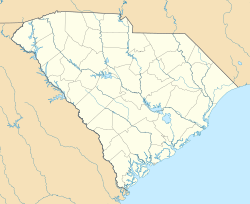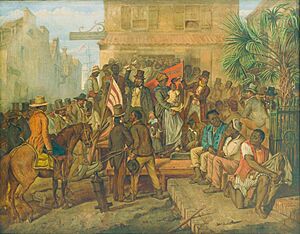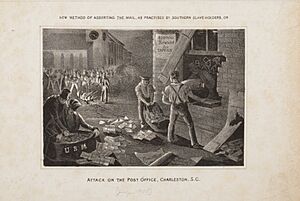Exchange and Provost facts for kids
|
Old Exchange and Provost Dungeon
|
|
|
U.S. National Historic Landmark District
Contributing Property |
|

Exchange and Provost in 1977
|
|
| Location | E. Bay and Broad Streets, Charleston, South Carolina |
|---|---|
| Built | 1767 |
| Architect | William Rigby Naylor |
| Architectural style | Georgian |
| Part of | Charleston Historic District (ID66000964) |
| NRHP reference No. | 69000160 |
Quick facts for kids Significant dates |
|
| Added to NRHP | December 17, 1969 |
| Designated NHL | November 7, 1973 |
| Designated NHLDCP | October 9, 1960 |
The Old Exchange & Provost Dungeon is a very old and important building in Charleston, South Carolina. It is also known as the Custom House or The Exchange. This historic building is located at East Bay and Broad Streets. It was built a long time ago, between 1767 and 1771. Over the years, it has been used for many different important jobs. During the American Revolutionary War, British forces used its basement as a prison for captured soldiers. Because of its history, the building was named a National Historic Landmark in 1973. Today, it is a museum run by the Daughters of the American Revolution.
Contents
Exploring the Old Exchange Building
The Old Exchange building stands on the east side of Charleston's historic downtown. You can find it at the corner of East Bay and Broad Streets. It is a two-story building made of strong stone. It has a sloped roof with a small tower called a cupola on top. The building sits on a tall brick basement.
What the Building Looks Like
The main front of the building faces west. It has a part that sticks out in the middle with three sections. On the first floor, there are three arched doorways. On the second floor, there are windows with tall, thin columns called Ionic pilasters between them. The sides of the building each have a special window design called a Palladian window. These windows sit on a brick base with a decorative railing.
A Look Back at the Old Exchange's History
The Old Exchange was built by the government of South Carolina between 1767 and 1771. In the 1700s, it was used for many important community tasks. It served as a custom house, where taxes on goods were collected. It was also a public market and a place for public meetings. Sometimes, it even worked as a jail.
The Revolutionary War Years
During the American Revolution, important events happened here. In 1774, tea that was taken from ships was stored inside. South Carolina's leaders also held their important meetings here. When the British army took control of Charleston in 1780, they used the building as a place for their soldiers to stay. The basement became a military prison.
In 2012, experts studied how the building was used as a British prison. They found records of at least 120 prisoners held there. Many more prisoners were likely held, but their names are not known. Not only American soldiers were held there; some British soldiers were also kept in the prison.
After the Revolution
In 1788, South Carolina leaders met in this building. They voted to approve the United States Constitution. This was a very important step in forming the United States. George Washington, the first president, visited Charleston for a week. He was greeted by a large crowd from the building's balcony.
The building continued to be an "Exchange" for many years. It also became a post office in the 1800s. The area in front of the building was a busy market. Many different goods were bought and sold there. People would often visit the Exchange to get their mail. They would also see the crowds gathered for market days. In 1835, the postmaster here protected mail containing ideas about freedom from angry people in Charleston.
Through the Civil War and Beyond
During the American Civil War, the building was still a post office for the Confederate side. However, it was hit by several cannon shells during the war. Because of the damage, it was left empty for a while.
In 1913, the building was given to the Daughters of the American Revolution. This group has worked to protect and preserve it ever since. During World War I, the building was used as army headquarters. It also housed the United States Lighthouse Service. In World War II, it became a USO center. This was a place where soldiers could relax and get food. It also served as a lookout station for the United States Coast Guard.
In 1965, an even older structure was found underneath the building. It was a part of a 1698 fort called the Half-Moon Battery.
Changes to the Building's Top
The first cupola, or small tower, on top of the building was damaged by a hurricane in the early 1800s. The second one wore out before a big earthquake in Charleston in 1886. The third cupola was not put in place until 1981. That's when the building officially opened as a museum.
Visiting the Museum Today
The South Carolina Society of the Daughters of the American Revolution owns the Old Exchange. They offer guided tours where you can explore all three floors. The Provost Dungeon in the basement used to have moving figures that told stories of pirates and colonial times. Now, friendly guides lead personal tours through the dungeon. They share fascinating stories about the building's past.
See also





